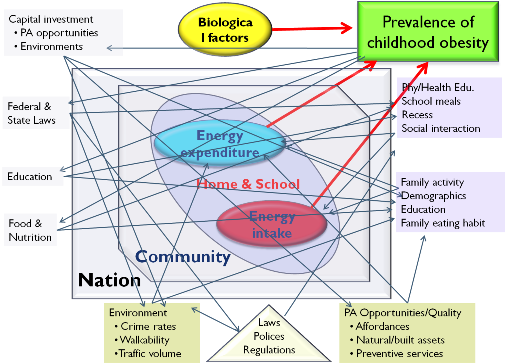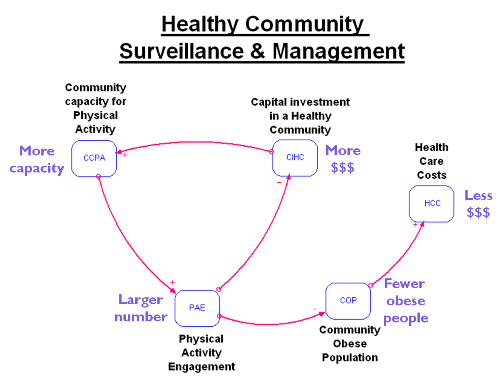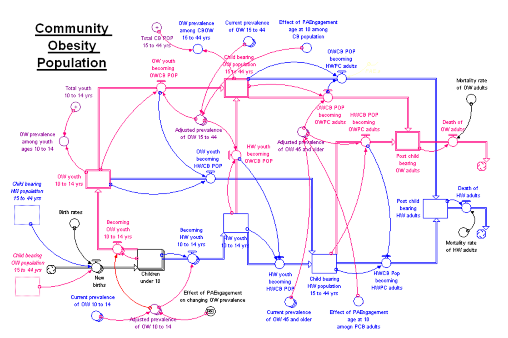Getting Kids off the Couch and Into Healthy Communities: Modeling Recreation Programs with STELLA
 David Compton
David Compton
If you’re a 13-year-old who loves video games, Instagram and Cheetos, chances are someone – your parents, your teacher, the school nurse, Michelle Obama – is on your
back to get up off the couch and be more physically active and socially engaged. They’re also encouraging you to eat nutritious food. They’re worried about your health;
the scary probability that you’ll become obese and suffer from diabetes or heart disease or other chronic illnesses. But what if you don’t have the opportunity or support
you need to orchestrate major lifestyle changes?
“Kids between the ages of 5 and 10 are active and engaged,” says David Compton, founder of the Healthy Communities Research Group and Professor Emeritus at the University
of Indiana and University of Utah. “They’re encouraged by their parents and enrolled in programs that support physical and social engagement and offer snacks. But by age 10,
increased athletic competition, the cost of uniforms and travelling teams, complex logistics and parental structures make it difficult or impossible for kids to participate.
By age 15, skill requirements are even higher, parents are more disconnected or absent, and only the very best athletes are retained.”
That’s a problem for kids who really do risk their health when physical activity, social engagement and nutrition are traded for solitary, sedentary, digital endeavors.
It’s also a huge problem for society that is paying a higher and higher cost for health problems associated with obesity.
“In 2007, about one-third of 10-to-17-year-olds were overweight,” says Kiboum Kim, Senior Research Associate at the Healthy Communities Research Group citing a 2010 study
conducted by Barclay. “Fifty percent of obese children and 80% of obese adolescents remain obese as adults. If kids have two obese parents, they have an 80% chance of being
obese themselves. That’s important to understand because as more obese adults become parents, it creates a reinforcing loop and there will be more obese children.”
...as more obese adults become parents, it creates a reinforcing loop and there will be more obese children
Kim also points out the costs – personal and societal – of obesity. “The annual medical costs encountered by an obese child are three times that of a healthy weight child.
Obese adults spend $2,741 more on health care than their healthy weight peers. Obesity already accounts for 22% of medical spending. As obesity rates increase, so do
associated medical costs. In fact, each year between 2001 and 2006, medical costs increased about 10% for the obese population and 6% for the overweight population.
Costs will increase at even higher rates in the future.”
“The data shows real evidence of an obesity pandemic,” says Compton. “But, there are few coordinated efforts to get and keep young people socially and physically active.
As we’ve looked at the data, we’ve come to understand the link between the increase in obesity and decrease in youth activity to be a system problem.”
 Childhood obesity rates are influenced by a complex social system
Childhood obesity rates are influenced by a complex social system
It’s not surprising that Compton would immediately see the systemic nature of childhood obesity. “I started doing system analytics in the 1970s when it was crude,” he says.
He introduced Kim, his student at the University of Utah, to system dynamics and STELLA. When Compton founded Healthy Communities Research Group, a multidisciplinary look
at the relationship between parks and recreation agencies and health, Kim took up the task of creating a model of the system.
“We brought together anthropologists, educators, public health officials, exercise physiologists, nutritionists, community planners, and landscape architects to formulate
a strategy for using parks to influence youth obesity rates,” says Compton. Now, Healthy Communities works in partnership with Green Play Research, Education, and Development
(GPRED), an organization that helps public agencies create innovative programs that promote physical and social engagement in ways that improve individual and public health.
The Healthy Communities model creates a platform for cities, counties, and districts that seek to establish coordinated efforts to impact behavioral outcomes
Built using STELLA from isee systems, the Healthy Communities model creates a platform for cities, counties, and districts that seek to establish coordinated efforts to
impact behavioral outcomes through systems analytics, database management, and ongoing surveillance of public health. The platform includes documented GIS documentation
of built and natural assets – pools, playing fields, gyms, trails, open space, etc. – and data describing their service level quality, utility and proximity to youth
populations.
“To that data we add an innovative layer of ‘affordances,’” explains Compton. “Affordance data catalogs services, programs, lessons, and activities that are available to the
public by age, location, skill level, frequency, season, activity type, and other factors. They might be under the auspices of public parks and recreation departments or
delivered in conjunction with contractors, associations, other non-profits or specialized service providers.”
Information about local policies, ordinances, laws and rules (like skateboard park or bike access restrictions) is added to the platform. When available and applicable,
Healthy Communities adds data describing evidence-based practices that engage and sustain youth in active environments.
“The model is very complex and can be huge,” says Kim. “STELLA has made it easy to break the model into five modules that are consistent across public entities but unique in
how they work together. Different agencies or organizations can tailor the model to reflect their use of funds, staff deployment, specific policies, or other variables.”
Modeling how money is used for youth programs, funding sources and capital investment, population of 10 – 14 year olds, engagement in physical activity, and health care costs,
the modules work together to form a surveillance and management system for a healthy community.
 This top-level view of the model shows interactions between its five modules
This top-level view of the model shows interactions between its five modules
“We need to find ways to change habits of children to turn the obesity pandemic around,” says Compton. “We’re seeing that the deification of sport is a key factor in the
physical activity and engagement drop-out rate. Parks and recreation agencies and the communities that fund them should consider redirecting funds from competitive, or
consequential activities to non-competitive, or non-consequential activities for kids that want to participate for fun. And they need to understand and address other
factors in the drop-out rate.”
 The Community Obesity Population Module describes the prevalence of obesity in various age groups
The Community Obesity Population Module describes the prevalence of obesity in various age groups
Kim explains that the model shows how a diversion of funds from consequential to non-consequential activity impacts obesity rates and health care costs. It also illustrates
how new approaches to youth recruitment and retention are needed. “Some agencies will have to change their culture,” says Compton. “They’ll have to learn how to treat
eligible young people like customers.”
Storytelling helps illustrate the model to people who aren’t familiar with Systems Thinking
“It’s essential to use STELLA as a training tool,” says Compton. “Storytelling helps illustrate the model to people who aren’t familiar with Systems Thinking. It shows
them that they need to do more than simply move people through the turnstiles. They need to document quality and retention to get results.”
The model is currently helping to identify youth program innovations in South Bend, Indiana, and Liberty, Missouri. Working through GPRED, Healthy Communities is reaching
out to more public entities that fund facilities and certified youth activity programs. With 7500+ public parks and recreation agencies located across the US, the model
offers administrators a systems analytics approach to managing obesity over the long term through surveillance and improved, evidence-based practices.
To learn more about Healthy Communities, visit Healthy Communities Research Group
David Compton — compton@indiana.edu, (801) 673-2907
Kiboum Kim — kimki@indiana.edu, 812-929-0363